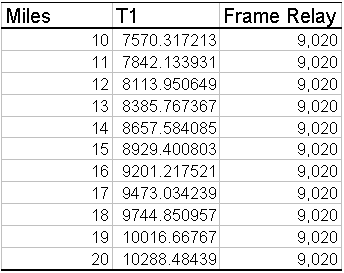
Since both can deliver the same bandwidth, a cost comparison is intuitive. The factors that are considered in this cost analysis are the one-time installation fee, monthly tariffs for service, and distance costs. We received the tariff information used for this analysis from Pacific Bell. The T1 tariff information was collected from a phone interview; the frame relay tariff information is publicly available on their homepage. While frame relay has higher monthly service tariffs (over $300 more per month), this difference is quickly exceeded by the distance-sensitive fees involved in purchasing dedicated T1 service. The pricing of frame relay tariffs is distance insensitive.

The cost analysis considers the NPV of the first-year expenses in purchasing both services. The factor varied is the number of miles separating the two offices that one desires to connect. The following chart shows the first-year NPV for each service as a function of the miles separating two offices.


The discount rate used in this analysis was .08. A risk factor of .06 was also introduced. This analysis could be extended to include the CPE costs so that any differences between these costs could be taken into account. From a conversation with a representative of a CSU/DSU vendor, however, it was determined that there was no difference in the price of routers and CSU/DSUs for the two technologies. That is the primary reason that this information was ignored in the analysis.